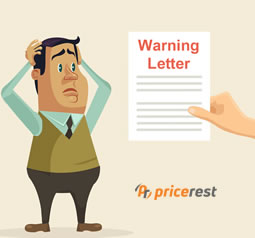In the fiercely competitive world of online sales, the necessity of minimum advertised price (MAP) violation monitoring cannot be overstated. Manufacturers who distribute their products with a set MAP policy need to be vigilant in ensuring that their pricing guidelines are being adhered to at all times. This vigilance is especially crucial for manufacturers who sell products on large e-commerce platforms like Amazon, where monitoring each seller for MAP violations is challenging yet essential.
Table Of Content For MAP Monitoring In E-Commerce
- What is MAP Violation Monitoring?
- What is the minimum advertised price monitoring?
- Why is minimum advertised price monitoring necessary for e-commerce?
- Who enforces MAP pricing?
- In what ways does MAP monitoring help manufacturers?
- Can You Sell Above MAP Pricing?
- Who Enforces MAP Pricing?
- Is Minimum Advertised Pricing (MAP) illegal?
- Additional Resources
- Conclusion
What is MAP Violation Monitoring?
MAP violation monitoring involves tracking the prices at which products are advertised by various retailers to ensure compliance with the manufacturer’s set minimum advertised price. This type of monitoring is crucial for maintaining brand integrity, ensuring fair competition among retailers, and safeguarding profit margins.
What is the minimum advertised price monitoring?

Minimum advertised price (MAP) monitoring is the process of tracking and enforcing a set minimum price for products advertised by retailers. This type of monitoring helps manufacturers maintain brand integrity, promote fair competition among retailers, and protect profit margins. It involves regularly checking product listings and utilizing advanced tools to identify any violations and take appropriate action. MAP monitoring is especially crucial in the highly competitive world of e-commerce, where pricing plays a significant role in consumer purchasing decisions. So, manufacturers must stay vigilant and continuously monitor their products across various online platforms to ensure compliance with their set MAP policies.
Why is MAP Violation Monitoring Important?
1. Protects Brand Integrity
When a manufacturer sets a MAP policy, they are establishing a standard that reflects the perceived value of their product. If retailers advertise products below this set price, it can harm the brand’s reputation by making it appear less valuable.
 2. Ensures Fair Competition
2. Ensures Fair Competition
Adhering to MAP policies ensures a level playing field among retailers. When one retailer advertises a product below the MAP, it can unfairly disadvantage other retailers who are complying with the pricing guidelines.
3. Safeguards Profit Margins
MAP violations can lead to price wars, eroding profit margins not only for the retailers but also for the manufacturers. By enforcing MAP policies, manufacturers can help maintain healthy profit margins across their distribution channels.
Key Points for MAP Violation Monitoring
- Manufacturer Price Monitoring: Regularly monitor the prices at which your products are advertised to ensure compliance with your MAP policy.
- MAP Monitoring Tools: Utilize advanced software tools that automatically scan the web for MAP violations, providing real-time alerts and detailed reports.
- Enforcement on Large Platforms: Understand the specific challenges and strategies for enforcing MAP pricing on major platforms like Amazon.
- Addressing Price Violations: Develop a clear and consistent approach for addressing MAP violations, including direct communication with the offending retailer and potential consequences for repeat offenders.
Benefits of MAP Violation Monitoring for Manufacturers

1. Streamlined Regulation Across Sellers
One of the first challenges manufacturers face when entering online selling markets is regulating their price tags with different sellers. MAP monitoring streamlines this process, ensuring consistency across all retail channels.
2. Enhanced Control Over Pricing
Even with MAP policies in place, monitoring each retailer or seller, especially on large platforms like Amazon, can be daunting. Effective MAP monitoring provides manufacturers with greater control over how their products are priced and advertised.
3. Protects Long-Term Business Interests
By diligently enforcing MAP policies, manufacturers protect their long-term business interests. Consistent pricing helps to establish trust with consumers and maintains a stable market position.
Enforcing Your MAP Pricing on Amazon

Enforcing MAP pricing on Amazon requires a strategic approach:
- Automate Monitoring: Use automated tools that continuously track your product listings on Amazon for any MAP violations.
- Set Clear Consequences: Ensure retailers understand the consequences of violating MAP policies, such as reduced supply or termination of their authorization to sell your products.
- Direct Communication: Establish direct lines of communication with retailers to promptly address any violations and take corrective action.
MAP violation monitoring is essential for protecting brand integrity, ensuring fair competition, and safeguarding profit margins in the competitive e-commerce landscape. By leveraging advanced monitoring tools and implementing clear enforcement strategies, manufacturers can effectively manage their pricing policies and maintain a strong presence in the market.
Don’t let MAP violations undermine your brand’s value. Take control today by investing in robust MAP violation monitoring solutions and ensure your products are always advertised at the right price.
Why is minimum advertised price monitoring necessary for e-commerce?
- Maintains Brand Reputation: MAP violation monitoring helps protect the perceived value and integrity of a brand by ensuring products are advertised at a consistent price across all retail channels.
- Promotes Fair Competition: By enforcing MAP policies, manufacturers promote fair competition among retailers, preventing one seller from gaining an unfair advantage over others by undercutting prices.
- Preserves Profit Margins: MAP monitoring helps prevent price wars and ensures healthy profit margins for both manufacturers and retailers, ultimately supporting sustainable business growth.
- Ensures Consistency: With numerous retailers selling products online, it can be challenging to maintain consistent pricing without proper monitoring. MAP violation monitoring streamlines this process and ensures consistency across all sales channels.
- Protects Long-Term Interests: By diligently enforcing MAP policies, manufacturers protect their long-term business interests by establishing trust with consumers and maintaining a stable market position. Overall, MAP monitoring is necessary for e-commerce to promote fair competition, maintain brand reputation, and safeguard profit margins. So, it is essential for manufacturers to have robust MAP violation monitoring strategies in place to effectively manage their pricing policies and ensure compliance across all retail channels. With the help of advanced tools and clear enforcement strategies, manufacturers can successfully navigate the competitive e-commerce landscape and maintain control over how their products are advertised and sold. So, implementing MAP monitoring should be a priority for any business operating in the online marketplace.
Who enforces MAP pricing?

MAP pricing is primarily enforced by the manufacturers or brand owners of a product. They have the authority to set and enforce a minimum advertised price for their products. However, in some cases, retailers may also play a role in monitoring and enforcing MAP policies, especially if they have signed agreements with the manufacturer or are authorized resellers. Additionally, government agencies such as the Federal Trade Commission (FTC) may also enforce MAP policies if they violate antitrust laws or harm competition in the marketplace. Overall, it is ultimately the responsibility of manufacturers to ensure their products are advertised at the minimum price set by them and take appropriate action against any violations. So, having a strong MAP violation monitoring system in place is crucial for manufacturers to effectively enforce their pricing policies. This includes utilizing automated tools, establishing clear consequences for violations, and maintaining direct communication with retailers. By taking a proactive approach to MAP monitoring, manufacturers can protect their brand’s reputation, promote fair competition, and maintain healthy profit margins in the ever-changing world of e-commerce.
In what ways does MAP monitoring help manufacturers?
- Protects Brand Reputation: By enforcing a consistent minimum advertised price, manufacturers can maintain their brand’s perceived value and integrity in the marketplace.
- Ensures Fair Competition: MAP monitoring helps prevent retailers from undercutting one another and promotes fair competition among all sellers.
- Safeguards Profit Margins: With proper MAP monitoring, manufacturers can prevent price wars and ensure healthy profit margins for both themselves and their retailers.
- Maintains Control: By regularly monitoring MAP violations, manufacturers can maintain control over how their products are advertised and sold across different retail channels.
- Supports Long-Term Growth: Effective MAP monitoring helps establish trust with consumers, protect long-term business interests, and support sustainable growth for manufacturers. In summary, implementing a robust MAP violation monitoring system benefits manufacturers in various ways, from protecting their brand’s reputation to supporting long-term growth. It is a crucial tool for success in the competitive e-commerce landscape and should be a priority for all manufacturers. So, investing in advanced MAP violation monitoring solutions is essential for businesses looking to maintain control over their pricing policies and ensure compliance across all retail channels. By staying vigilant and proactive, manufacturers can effectively enforce MAP policies and safeguard their brand’s reputation, fair competition, and profit margins in the online marketplace. Overall, MAP monitoring is a necessary aspect of successful e-commerce operations for manufacturers and should not be overlooked.
Can You Sell Above MAP Pricing?

Yes, retailers are allowed to sell products above the Minimum Advertised Price (MAP). MAP policies are designed to establish the minimum price that can be advertised and publicized to customers. However, these policies do not restrict the maximum price at which a product can be sold. Retailers have the flexibility to set their final selling prices above the MAP, based on their business strategy, customer demand, and market conditions. This flexibility allows retailers to potentially increase profit margins while still complying with the manufacturer’s pricing guidelines. It is important for retailers to understand the distinction between MAP and the selling price to ensure both compliance with policies and optimization of their pricing strategy.
Who Enforces MAP Pricing?

Enforcing MAP pricing typically falls under the responsibility of the manufacturers. They are the ones who create the MAP policies and have a vested interest in ensuring these policies are adhered to in order to protect their brand image and maintain fair market competition. Manufacturers often utilize various tools and strategies to monitor compliance, such as sophisticated software solutions that track advertised prices across multiple online platforms and marketplaces. If a retailer is found to be in violation of MAP policies, the manufacturer can take corrective actions such as issuing warnings, suspending future shipments, or even terminating the business relationship. While manufacturers are primarily responsible for enforcement, retailers also play a crucial role by understanding and adhering to MAP agreements, thereby fostering a healthy competitive environment.
Is Minimum Advertised Pricing (MAP) illegal?

No, MAP policies are not illegal. In fact, they are a common business practice used by manufacturers to protect their brand and maintain fair competition among retailers. However, it is illegal for manufacturers to directly set or enforce retail prices. MAP policies only set a minimum price that retailers cannot advertise below; they do not dictate the final selling price. Enforcement of MAP policies should be done carefully and consistently to avoid any legal implications. Overall, MAP policies are a valuable tool for manufacturers in managing their pricing and protecting their business interests. In order to ensure compliance with antitrust laws, it is important for manufacturers to provide clear guidelines and consequences for violating MAP policies. Additionally, working closely with legal counsel can help navigate any potential legal issues that may arise. With proper monitoring and enforcement, MAP policies can help manufacturers maintain a strong brand presence and healthy profit margins.
Additional Resources
Conclusion

In conclusion, minimum advertised price (MAP) monitoring is crucial for e-commerce as it promotes fair competition, maintains brand reputation, safeguards profit margins, ensures consistency, and protects long-term business interests. Manufacturers have the primary responsibility for enforcing MAP policies but may receive support from retailers and government agencies. By implementing effective MAP violation monitoring strategies, manufacturers can maintain control over their pricing policies and ensure compliance across all retail channels. It is an essential tool for success in the competitive e-commerce landscape and should not be overlooked by businesses. In summary, MAP monitoring is necessary for a fair and healthy online marketplace, benefiting both manufacturers and consumers alike. So, investing in advanced MAP violation monitoring solutions should be a priority for all businesses operating in the e-commerce space.
The benefits of MAP monitoring are clear, and it should be an essential part of every manufacturer’s business strategy for long-term success in the e-commerce industry. With that, we conclude our discussion on the importance of MAP violation monitoring for manufacturers. Thank you for reading! We hope this document has provided valuable insights and information on the topic. Here’s to compliance, fair competition, and success in e-commerce!
Happy selling!

Do you want to be a successful player in e-commerce?
- You must keep a close monitoring on what your competitors are doing
- Know the product’s pricing points.
- Use Price Monitoring Tools
- Use Dynamic Pricing Strategies
- Automatically Update Your Products According To Your Competitors.
Join PriceRest for better dynamic pricing strategies for your short- and long-term sales processes.
To have a better understanding of e-commerce for success, join today!
And see What PriceRest can do for you.
Request a personalized demo of PriceRest
We look forward to showing you how our platform allows you to optimize the pricing, execution, and measurement initiatives that matter most to your brand and products.
It is Free!
What can I expect?
- A brief conversation to assess what PriceRest can do to help your pricing strategy
- Live product demo with insight into how to get the most benefit from PriceRest
- Discuss your prices KPIs to determine the best path forward for your business
- No commitment required

